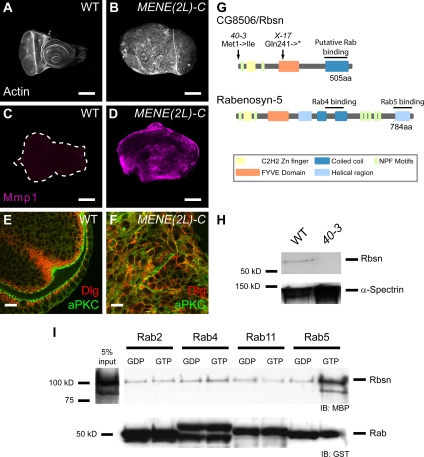Figure 1.
MENE(2L)-C mutations disrupt Drosophila Rabenosyn, which is a Rab5 effector and neoplastic tumor suppressor. Single confocal sections of WT (A) and entirely mutant MENE(2L)-C (B) eye discs stained with phalloidin to mark actin. MENE(2L)-C discs are larger than WT discs and lack their distinctive apical enrichment of actin filaments. MENE(2L)-C discs express Mmp1 (D; magenta), a marker correlated with neoplastic tissue, at significantly higher levels than WT discs (C). (E and F) Eye discs stained for aPKC to mark apical surfaces (green) and Dlg to mark basolateral surfaces (red). Wild-type cells have distinct aPKC and Dlg domains (E), whereas aPKC and Dlg are intermixed in MENE(2L)-C cells (F). (G) Locations of the lesions in the MENE(2L)-C40-3 (40-3) and MENE(2L)-CX-17 (X-17) alleles are indicated. Protein domains are labeled as colored boxes according to legend, compared with human Rabenosyn-5. (H) Western blot of wild-type and MENE(2L)-C40-3 mutant imaginal disc extracts probed with anti-Rbsn (top) or anti-α-Spectrin antibody as a loading control (bottom). (I) In vitro GST pull-down assays between recombinant MBP-Rbsn and GST-Rab proteins. Western blots against MBP (top) to detect bound Rbsn and GST (bottom) as a loading control. GST-Rab2 is included as a negative control, showing that Rbsn binds specifically only to Rab5-GTP. Bars, 100 μm (A–D) and 10 μm (E and F).

